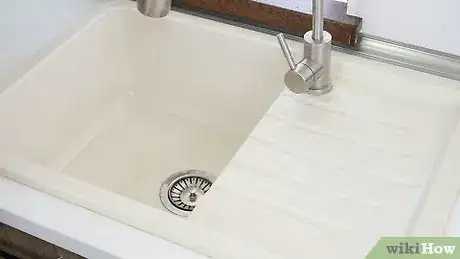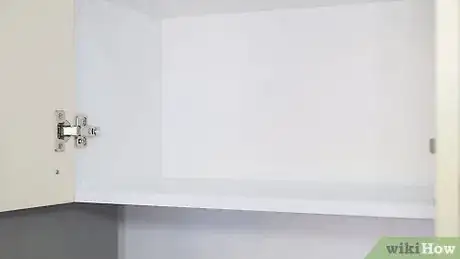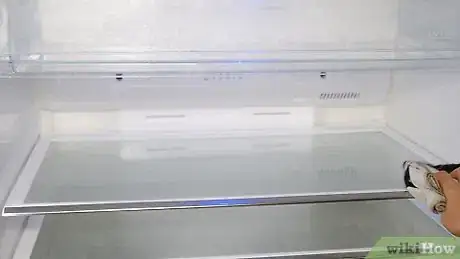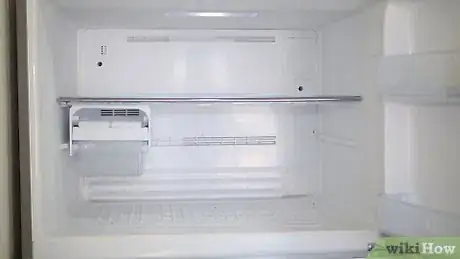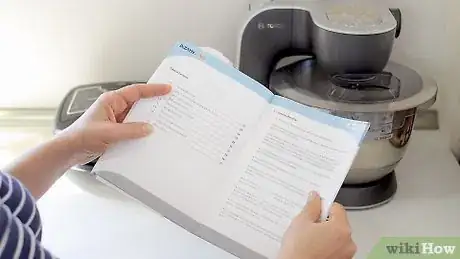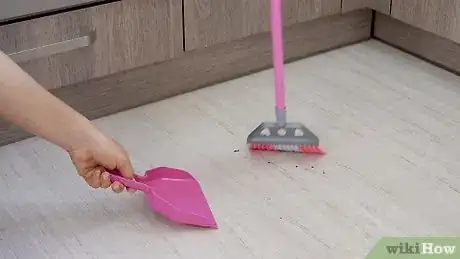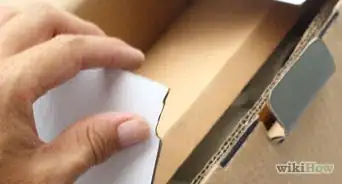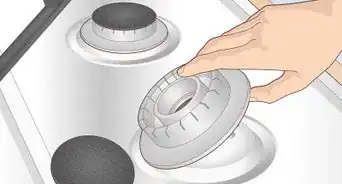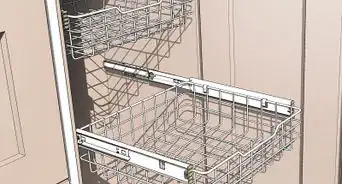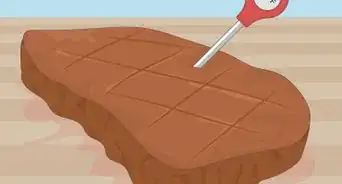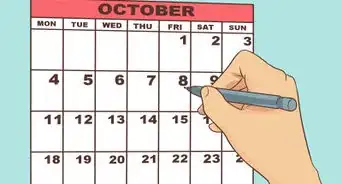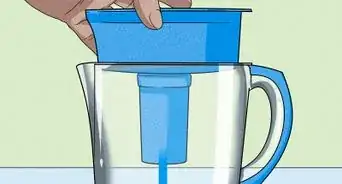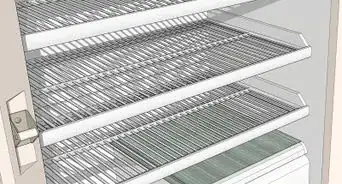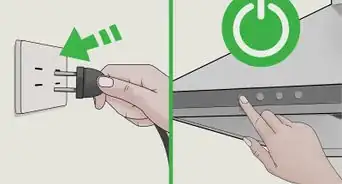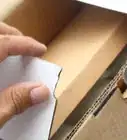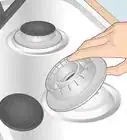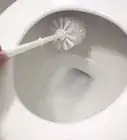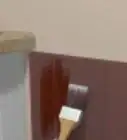This article was co-authored by Ashley Matuska. Ashley Matuska is a Professional Cleaner at the Founder and Owner of Dashing Maids in Denver, Colorado. Ashley has over seven years of experience in the cleaning industry. She and her team specialize in offering sustainable deep cleaning and maintenance cleaning services.
There are 10 references cited in this article, which can be found at the bottom of the page.
wikiHow marks an article as reader-approved once it receives enough positive feedback. In this case, 98% of readers who voted found the article helpful, earning it our reader-approved status.
This article has been viewed 602,476 times.
Cleaning the kitchen might seem a little overwhelming, but once you get going, you'll find a groove and feel a sense of accomplishment. But what's the proper way to clean a kitchen? Where should you even start? We'll teach you a basic kitchen-cleaning routine so you hit all the major dirty parts of your kitchen and learn to clean your kitchen like a pro.
Steps
Cleaning the Sink
-
1Wipe the basin and fixtures of the sink. To avoid mold growth or water stains, wash the basin with warm, soapy water and a sponge. Rinse along the edge of the basin, as well. Remove water stains from the fixtures.
- You can also clean a sink with a 1:2 ratio of baking soda to white vinegar. Just sprinkle the baking soda around the sink, then pour white vinegar and let the mixture fizzle for a few minutes.[1]
-
2Clean around the faucet. To clean hard to reach crannies of the faucet, use a toothbrush dipped in warm, soapy water. Buff out any water spots left behind with a dry cloth.Advertisement
-
3Get rid of mineral deposits. If your water has a high mineral content, you may notice a mineral deposits. To get rid of these deposits, combine one part water with one part white vinegar. Gently scrub away the deposit with a rag. Rinse the area and let it dry.[2]
-
4Keep your garbage disposal working properly. If your sink is having a hard time draining, run the garbage disposal to get rid of anything that might be lurking down there. Its important to sanitize your disposal once in a while as well. Make frozen cubes of vinegar in an ice tray, drop them down the disposal, then pour boiling water into it as you run the disposal. This will also sharpen your garbage disposal’s blades.
Cleaning Cabinets and Counters
-
1Clean out your cabinets. Whether they contain food, kitchen supplies, or your secret stash of candy, clean your cabinets out every once in a while. Throw away expired items and wipe the cabinets with a wet, soapy rag to remove dust and crumbs.[3]
-
2Clean the front of your cabinets. Grime and grease can build up on the fronts of cabinets. Wipe them down with a wet rag and dry them thoroughly to avoid any color distortion.[4]
- If you have wooden cabinets, consider using a cleaning supply specifically made for wood.
-
3Wipe down your counters. You should do this every night after you are done cooking. Use a sponge and soapy water to wipe counters down. Wipe them dry with a clean rag or paper towels.[5]
- You could also buy some cleaning supplies to wipe your counters down with. There are many anti-bacterial sprays, disposable wipes and de-greasing products.
- If your counters are made with granite or stone, you should use cleaning supplies specifically made for that kind of countertop.
Cleaning the Stove Top
-
1Wipe the burners. You have to clean your gas or electric burners every now and then. Gas burners can be removed and washed by hand with warm water and soap. If you are lucky to have gas burners that can go into the dishwasher, throw them in there after you scrub off excess food. For electric burners, wipe debris with a moist sponge.[6]
- The type of grate determines how you wash your burners. If you have an uncoated grate, use a scouring pad to clean the grate. If you have a coated grate, use a soft sponge.
-
2Wipe the stove surface. Use a sponge and soap, or invest in some Clorox wipes to really break down those stains. If grease spills on your stovetop, clean it up right away because it becomes difficult to remove as it hardens.
- Scrape off burnt-on food with a wet razor blade or a pumice stone.[7]
-
3Remove the control knobs and wash them. Wash them in the sink using warm water and mild dish soap. Avoid using a soap that has abrasives or ammonia in it, as these components will wash away the markings on the knobs.
-
4Wipe the outside of the vent hood. Use a soapy cloth to clean the vent hood. Wash away the suds with a damp cloth, then dry with a dry cloth. Once a month, remove the vent filters and soak them in warm, soapy water. Gently scrub to clean, then let them dry thoroughly before putting them back.[8]
- If you have a stainless steel hood, use a cleaning product meant to be used on stainless steel.
Cleaning the Oven
-
1Clean the grates of the oven. Remove the grates from the oven. Fill a tub or bucket with warm, soapy water and soak the grates for several hours. Anything coated on the grates will be easier to scrub off. Use a scouring pad to scrub the grates.
-
2Give your oven a good cleaning. You should deep-clean your oven every few months, or as soon as it starts to smoke while you are cooking. An effective oven cleaning mixture is ¼ cup salt, ¾ cup baking soda, and ¼ cup water. Cover any bare metal or clog openings with foil so that they do not get damaged by the mixture.[9]
- If you have an electric stove, remove the racks and put the oven on cleaning mode. When the cycle has ended, use a damp cloth to remove any residue left by the cleaning cycle.
-
3Spread the mixture all over the inside of the oven and let it remain overnight. Use a plastic spatula to remove the mixture. Wipe the oven clean with a rag. Replace the racks when they are dry.
Cleaning Out the Fridge
-
1Remove all food from the fridge. Sort through each item. Throw out any items that have expired or gone bad. If possible, do this before going grocery shopping so that the old expired stuff can be thrown out, thus making space for new groceries.
- Combine two tablespoons baking soda and one quart water. Dip a sponge in the solution, then wipe down the entire surfaces of the fridge, making sure to scrub out sticky stains.[10]
- Wipe down every drawer and shelf, not just the main part of the fridge.
-
2Wipe the solution away with a damp cloth. Dip a clean rag in water and wash away any residue left behind by the baking soda solution. Use a clean towel to dry each surface.
-
3Leave a box of baking soda in the fridge. If your fridge smells bad, open a box of baking soda and leave it in the fridge. Baking soda absorbs odors and makes your fridge smell fresh.
Cleaning the Freezer
-
1Clean out the freezer. First, unplug the refrigerator. After you have done this, remove your frozen items. Throw out expired items and put the rest in a cooler while you clean.
-
2Cleaning solution. Combine 1 cup of water, 1 teaspoon dish soap, and 1 teaspoon white vinegar. Shake the solution well. If possible, put the solution in a spray bottle so you can just spray the whole freezer.[11]
-
3Spray the freezer with the mixture. Be sure to dowse every surface. If you don’t have a spray bottle, dip a clean rag or sponge in the mixture and wipe down every surface. After the freezer has been wiped down, dry it off with paper towels. Plug the refrigerator back in and restore your frozen goods to their proper places.
Cleaning Smaller Appliances
-
1Wipe down the microwave. Use warm, soapy water and a sponge to wipe any splatters inside your microwave. For really tough stains, use a mixture of 2 tablespoons (29.6 ml) of baking soda and 1 US-quart (950 ml) of water. Rinse with clean water, then dry with a clean rag.[12]
-
2Consult appliance manuals on the best way to clean small appliances. While you can simply wipe each part of an appliance (aside from the electrical part) you should always consult the manual that came with the appliance. Appliances you should clean include your...
- Toaster
- Coffee maker
- Blender
- Coffee grinder
-
3Keep all of the appliance parts together. When you clean your appliances, make sure you know where each part goes. Do not lose any parts of the appliance. Clean each appliance one at a time so as not to get confused.
Finishing Up
-
1Sweep the floor with a broom and dustpan. Before you deep clean your floor, sweep any specks of dust, crumbs, and garbage that might be on the floor.
-
2Mop your floor when necessary. Use a mop and bucket of soapy water to deep clean your floor.[13]
-
3Put everything back in its proper place. After you have finished cleaning, put all cleaning supplies back in their proper place so that you don't trip over them.
-
4Take out the trash. Last of all, take out the trash. You should do this last because while you are cleaning you will undoubtedly find things you will want to throw away. Wash the trash can with soap and water. Replace the bag with a new one.
Community Q&A
-
QuestionHow should I clean oily kitchen walls?
 Community AnswerUse a strong solution of lemon scented ammonia and hot water to cut grease. Wear rubber gloves. When walls and ceiling are done and dry, the heavenly fresh clean scent lasts for days.
Community AnswerUse a strong solution of lemon scented ammonia and hot water to cut grease. Wear rubber gloves. When walls and ceiling are done and dry, the heavenly fresh clean scent lasts for days. -
QuestionWhen washing kitchen walls, do I start at the top or bottom of the wall?
 Community AnswerStart from the top so the cleaning solution trickles to the bottom, making it easy and faster to wipe the whole wall.
Community AnswerStart from the top so the cleaning solution trickles to the bottom, making it easy and faster to wipe the whole wall. -
QuestionWhat natural products can I use to clean my oven? What products should you use to clean a kitchen?
 Community AnswerBaking soda and water can be used to clean the oven, safely and naturally and without toxic fumes. To clean the oven: Combine baking soda and a small amount of water to make a paste. Apply paste to walls of the oven. Sprinkle dry baking soda on the bottom of the oven. Spray dry baking soda with a little water. Let sit over night. Wipe out in the morning.
Community AnswerBaking soda and water can be used to clean the oven, safely and naturally and without toxic fumes. To clean the oven: Combine baking soda and a small amount of water to make a paste. Apply paste to walls of the oven. Sprinkle dry baking soda on the bottom of the oven. Spray dry baking soda with a little water. Let sit over night. Wipe out in the morning.
Warnings
- Never mix products that contain bleach with products that contain ammonia. The mixture makes a very poisonous gas.⧼thumbs_response⧽
- Keep all cleaning supplies and chemicals away from children and pets.⧼thumbs_response⧽
- Don't use bleach on dark or wooden floors.⧼thumbs_response⧽
- Never cook and clean at the same time; poisons may contaminate food.⧼thumbs_response⧽
Things You'll Need
- Dish soap
- Kitchen cleanser
- Glass cleaner
- Vinegar
- Ammonia
- Baking soda
- Broom
- Cloths or rags
- Kitchen spray
- Disinfectant
- Sponge for washing dishes
- Paper towels
- Floor cleaner
- Mop
- Bucket
- Abrasive sponge or steel wool
- Floor squeegee
- Vacuum
References
- ↑ https://www.bhg.com/homekeeping/house-cleaning/tips/how-to-clean-kitchen-sinks-drains/
- ↑ http://www.marthastewart.com/272072/a-clean-kitchen-top-to-bottom
- ↑ http://www.marthastewart.com/272072/a-clean-kitchen-top-to-bottom
- ↑ Ashley Matuska. Professional Cleaner. Expert Interview. 15 April 2019.
- ↑ http://www.realsimple.com/home-organizing/cleaning/kitchen/weekend-kitchen-cleaning-checklist-00000000000207/
- ↑ http://www.huffingtonpost.com/2013/06/26/clean-stove-top-naturally_n_3499261.html
- ↑ Ashley Matuska. Professional Cleaner. Expert Interview. 15 April 2019.
- ↑ http://www.marthastewart.com/272072/a-clean-kitchen-top-to-bottom
- ↑ http://www.thekitchn.com/cleaning-the-oven-thats-never-been-cleaned-liveblogging-the-kitchn-cure-fall-2013-195641
- ↑ http://recipes.howstuffworks.com/tools-and-techniques/cleaning-your-cooking-area/5-tips-for-cleaning-your-refrigerator-quickly.htm
- ↑ http://www.realsimple.com/home-organizing/cleaning/kitchen/how-to-clean-freezer-00000000057342/
- ↑ http://www.readersdigest.ca/home-garden/cleaning/10-easy-tips-cleaning-your-microwave-and-stove
- ↑ http://www.sheknows.com/parenting/articles/817541/Mopping-dos-and-don-ts
About This Article
To clean a kitchen, start by cleaning all of the appliances, like the oven, microwave, and stovetop, by wiping them down with a soapy cloth or sponge. You should also empty the fridge, wipe it down, and throw away any food that's expired. After that, clean out the cabinets and wipe them down, along with the countertops. Next, wash any dishes in the sink and clean the sink with a sponge and some white vinegar. Finish up by sweeping and mopping the floors. If you want to learn how to clean inside your cabinets and drawers, keep reading the article!
